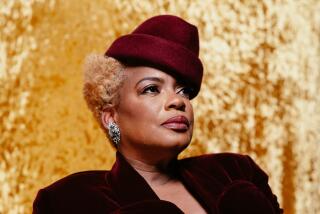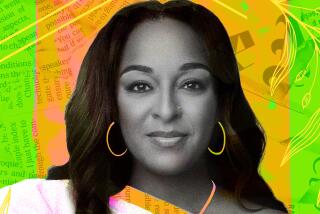Lessons in Reality : Faith Ringgold believes her mix of young characters, vibrant illustration and optimism help children understand the difficult and troubling adult issues she tackles in her books.
- Share via
On a recent afternoon, a crowd of children are gathered in a West Los Angeles bookstore. Seated on the carpet or snuggled in their parents’ laps, they listen to a story in a boldly illustrated picture book.
Dressed in a flowing black velvet gown, a heavy rhinestone necklace around her throat, author and illustrator Faith Ringgold reads, her voice low and reassuring.
Yes, it is a tranquil scene at Children’s Book World, a picture-perfect vision of early childhood. And yet the story being told is a frightening one, troubling even for adults.
*
Set in the Northeast in the 1800s, “Aunt Harriet’s Underground Railroad in the Sky” unflinchingly depicts the horrors of slavery and the harrowing journey escaping slaves endured on the Underground Railroad.
It is told through the experiences of 8-year-old Cassie Louise Lightfoot, a 20th-Century girl in Harlem whose optimism allows her to fly.
One day as she and her little brother Be Be fly over the city, they encounter a railroad train above the clouds bearing the slogan “Go Free North or Die,” its conductor a tiny African-American woman. Be Be leaps on the train and it disappears, leaving his frantic sister behind.
Then the conductor’s voice explains to Cassie, “I am Harriet Tubman . . . During slavery, I carried hundreds of men, women and children to freedom on the underground railroad.”
She tells Cassie she must follow her brother to Canada just as the 19th-Century slaves made their way north on the real Underground Railroad, because “though you can fly, being a slave will suck you to the ground like quicksand.”
Perhaps it is Cassie who makes the children feel at ease with the story line and haunting images. Or perhaps it is the happy ending as Cassie succeeds in reaching Canada, where she can fly again and brother and sister are reunited.
After the reading, the children flock around Ringgold to have their books signed. When a shy girl of about 9 approaches, her mother and father beside her, Ringgold puts an arm around her waist.
“To Fabienne,” Ringgold writes on the inside cover of her book. “Anyone can fly!”
*
For Ringgold, an artist whose painted story quilts--works combining paintings, quilted fabric and stories--hang in the Guggenheim among other preeminent museums in the country, becoming a children’s book author has launched her on a successful new career.
Her first picture book, “Tar Beach,” published in 1991, won numerous awards, including the Caldecott Honor Award for illustrators and the Coretta Scott King Award for Illustration. Based on Ringgold’s 1988 story quilt of the same name, it follows the adventures of Cassie and Be Be as they joyfully fly above 1930s Harlem.
The story, however, concerns more than the fulfillment of a child’s fantasy. “Tar Beach” also confronts racial discrimination, providing a hopeful vision of the power of individuals to escape constraints on their lives.
Cassie’s optimism--that people can transcend barriers and go anywhere they want--mirrors Ringgold’s own view. “I was always very hopeful that I could change things,” says Ringgold, who grew up in Harlem and still has a home there.
Although her parents were not able to attend college--her father drove a truck for the sanitation department, while her mother was a homemaker--they encouraged her ambition and love of art. Her mother, a gifted seamstress and clothing designer, was a major influence in Ringgold’s choice of quilts as an art form.
Ringgold earned bachelor’s and master’s degrees in art from City College of New York. Since the early 1980s, she’s been a professor of art at UC San Diego, and she divides her time between La Jolla and New York.
“I had a lot of support in my life and I was told very early on I was going to college. ‘Tar Beach’ is really my childhood and the inspiration I got from my family and my belief that I would do something some day,” Ringgold says.
“Aunt Harriet’s Underground Railroad in the Sky” centers on the theme of freedom. When the children are back together in Canada, Be Be explains his flight on the train: “Freedom is more important than just staying together, and what’s more I got to ride on the Underground Railroad with Harriet Tubman. Now I know what our great-great-grandparents survived when they were children.”
*
The book, which includes a bibliography and a map depicting the routes Tubman took, also features a brief biography of Tubman. The material was researched by Ringgold’s late sister Barbara Knight, to whom “Aunt Harriet” is dedicated.
Despite her enthusiasm for the subject, it was far from an easy book for Ringgold to illustrate and write. It took her a year and “1,000” drafts. During the long process, she showed versions of the book to her three grandchildren.
Ringgold’s biggest dilemma was how to tell children about slavery. Her solution was to use Cassie and Be Be as central characters so that her readers could identify with their feelings.
“If you want to explain it to kids, you need to explain it to them in a way they can understand. They can understand fear, being left alone, being taken away from their family. So I made them (Cassie and Be Be) a part of it.”
*
Still, for such a young audience, the book is filled with frightening images. There is a slave ship and a slave auction. Cassie is shown hiding in a coffin in a graveyard, trekking through swamps and sobbing when she finds her lost brother’s toy soldiers and baseball cap but not her brother. Early on, Tubman warns Cassie that if she is caught along the way, she will be “severely punished.”
Ringgold, who taught art to children in New York City public schools for years, does not apologize for the story’s bluntness or realism.
“I figured I can’t write it unless it’s grounded in some truth,” she says. “There’s no way I’m going to be able to pretend this was not a terrifying situation. I do know children love being frightened, so I feel a kind of confidence in understanding something about this.”
Nonetheless, some critics have questioned the ability of children to understand the text. “A couple of reviewers have said, ‘The kids won’t get it,’ ” Ringgold readily admits. “But if they get the book read to them, they get it.”
The desire to give children a truthful account of history was a compelling reason Ringgold took on such a difficult book.
“I was told at home about slavery,” she says, “because my parents knew when I got to school I was going to be confronted with it--and not in a gentle way. I was going to hear that slaves were happy-go-lucky and that things were not that bad.
“Kids don’t have any explanation for the situation that exists today,” she adds, “and I think that precipitates a lot of confusion for African-American children. All they know is they’re on the bottom and they’re staying there and they don’t understand why.”
*
Ringgold plans to do a third book about Cassie and Be Be. And although she was initially intimidated by the idea of writing for children, she now finds the process more satisfying than making her quilts.
“I think all my stories (in my quilts) are imaginative,” says Ringgold, “but with children there’s no limit with what you can do because they’re ready to throw reality to the wind. So having this audience is just a wonderful thing.”
More to Read
Sign up for our Book Club newsletter
Get the latest news, events and more from the Los Angeles Times Book Club, and help us get L.A. reading and talking.
You may occasionally receive promotional content from the Los Angeles Times.






